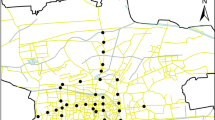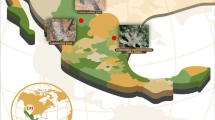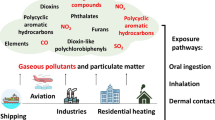Abstract
Objective This study was designed to comprehensively evaluate workers’ potential health risks of exposure to 39 air toxics in the Ta-sher Petrochemical Complex. Methods: Open-Path Fourier Transform Infrared Spectroscopy (OP-FTIR) was used to measure concentrations of air toxics. We used the measured worksite concentrations between 1997 and 1999 at 11 companies in the petrochemical complex, employing 3,100 on-site workers. The 39 measured air toxics included 10 chemicals with acute reference exposure levels (RELa), 19 chemicals with chronic reference exposure levels (RELc), and 3 chemicals classified as Class 1 or 2A human carcinogens by the International Agency for Research on Cancer (IARC). We then used RELa to calculate the hazard index of acute health effects (HI A ) for workers in individual plants. We also calculated the hazard index of chronic health effects (HIc) and cancer risks for all workers in the entire petrochemical complex. Results: Workers in five companies had HI A greater than 1 because of toluene, benzene, methyl ethyl ketone, chloroform and isopropanol exposures. Workers in this petrochemical complex had HIc greater than 1 because of acrylonitrile, 1,3-butadiene, hydrogen cyanide, and n,n-dimethylformamide exposures. Risk of hematopoietic system cancer because of benzene and ethylene oxide exposure, and respiratory system cancer because of 1,3-butadiene exposure was estimated to be 3.1–6.1×10−4 and 5.2–7.1×10−4, respectively. Conclusions: Our findings indicated that workers in the petrochemical complex might have excess cancer and noncancer risks due to acute or chronic exposures to air toxics from multiple emission sources.


Similar content being viewed by others
References
Cheng L, Fu L, Angle RP, Sandhu HS (1997) Seasonal variations of volatile organic compounds in Edmonton, Alberta. Atoms Environ 31(2):239–246
Cote I, Vandenberg J (1994) Overview of health effects and risk-assessment issues associated with air pollution. In: Isaacson R, Jensen K (eds) The vulnerable brain and environmental risks, vol 3. Toxins in air and water. Plenum Press, New York, NY, pp 231–245
Cupitt L, Cote I, Lewtas J, Lahre T, Jones J (1995) EPA’s Urban Area Source Research Program: A states report on preliminary research. US Environmental Protection Agency (EPA 600/R-95/027), Research Triangle Park, NC
Hassett-Sipple B, Cote I, Vandenberg J (1991) Toxic air pollutants and noncancer health risks—United States and a midwestern urban county. MMWR 40:278–280
Helse DR (1990) Less than obvious—statistical treatment of data below the detection limit. Environ Sci Technol 24:1766–1774
International Agency for Research on Cancer (IARC) (1997) Ethylene oxide, vol 60. IARC, Lyon, France
International Agency for Research on Cancer (IARC) (1998a) Occupational exposure to petroleum refining crude oil and major petroleum fuels, vol 45. IARC, Lyon, France
International Agency for Research on Cancer (IARC) (1998b) Benzene, Suppl 7. IARC, Lyon, France
International Agency for Research on Cancer (IARC) (1998c) Some monomers, plastics and synthetic elastomers, and acrolein, vol 19. IARC, Lyon, France
International Agency for Research on Cancer (IARC) (1999) Some monomers, plastics and synthetic elastomers, and acrolein, vol 71. IARC, Lyon, France
Leaderer BP, Lioy PJ, Spengler JD (1993) Assessing exposures to inhaled complex mixtures. Environ Health Perspect Suppl 101(S4):167–177
Office of Air Quality Planning and Standards (1990) Cancer risk from outdoor exposure to air toxics. US Environmental Protection Agency, Research Triangle Park, NC
Office of Environmental Health Hazard Assessment (1999a) Air Toxics Hot Spots Program risk assessment guidelines part I: Technical support document for the determination of acute reference exposure levels for airborne toxicants. California Environmental Protective Agency, Office of Environmental Health Hazard Assessment
Office of Environmental Health Hazard Assessment (1999b) Air Toxics Hot Spots Program risk assessment guidelines part II: Technical support document for describing available cancer potency factors. California Environmental Protective Agency, Office of Environmental Health Hazard Assessment
Office of Environmental Health Hazard Assessment (2000) Air Toxics Hot Spots Program risk assessment guidelines part III: Technical support document for the determination of noncancer chronic reference exposure levels for airborne toxicants. California Environmental Protective Agency, Office of Environmental Health Hazard Assessment
Perlin SA, Setzer RW, Creason J, Sexton K (1995) Distribution of industrial air emissions by income and race in the United States: an approach using the Toxic Release Inventory. Environ Sci Technol 29:69–80
Rosenbaum A, Axelrad D, Woodruff T, Wei Y, Ligocki M, Cohen J (1999) National estimates of outdoor air toxics concentrations. J Air Waste Manage Assoc 49:1138–1152
Samet JM, Speizer FE (1993) Introduction and recommendations: Working group on indoor air and other complex mixtures. Environ Health Perspec suppl 101(S4):143–147
Tsai SP, Wendt JK, Cardarelli KM, Fraser AE (2003) A mortality and morbidity study of refinery and petrochemical employees in Louisiana. Occup Environ Med 60:627–633
US Environmental Protection Agency (1990) Cancer risk from outdoor exposure to air toxics. EPA-450/1–90–004a
US Environmental Protection Agency (1999) Compendium Method TO-16: Long-path open-path Fourier transform infrared monitoring of atmospheric gases. US Environmental Protection Agency, Research Triangle Park, NC
Woodruff T, Axelrad D, Caldwell J, Morello-Frosch R, Rosenbaum A (1998) Public health implications of 1990 air toxics concentrations across the United States. Environ Health Perspect 106:245–251
Xu X, Cho SI, Sammel M, You L, Cui S, Huang Y, Ma G, Padungtod C, Pothier L, Niu T, Christiani D, Smith T, Ryan L, Wang L (1998) Association of petrochemical exposure with spontaneous abortion. Occup Environ Med 55:31–36
Acknowledgements
This study was supported by a grant from Taiwan Environmental Protection Agency (EPA-88-FA32-03-1001). We also want to thank the reviewers for their specific comments.
Author information
Authors and Affiliations
Corresponding author
Rights and permissions
About this article
Cite this article
Chan, CC., Shie, RH., Chang, TY. et al. Workers’ exposures and potential health risks to air toxics in a petrochemical complex assessed by improved methodology. Int Arch Occup Environ Health 79, 135–142 (2006). https://doi.org/10.1007/s00420-005-0028-9
Received:
Accepted:
Published:
Issue Date:
DOI: https://doi.org/10.1007/s00420-005-0028-9




